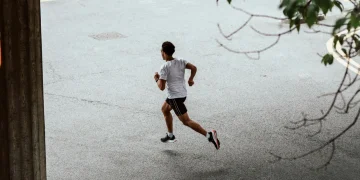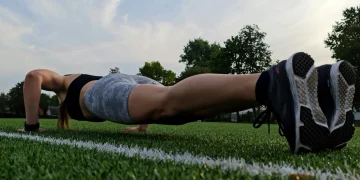Many people give up running out of fear of injury. And those who have already devoted themselves to running don’t always think about the health of their legs.
But this is a crucial aspect: the more miles you run, the more your joints, cartilage, and muscles are loaded. And no matter how good you feel during your morning run on asphalt, the reality is that the body will respond to your movements.
It is worth recognizing that sore hamstrings from running occur in most runners. Sore hamstrings after running are sometimes accompanied by microtraumas and complete tissue ruptures. According to medical statistics, runners and people whose work is associated with daily physical activity often suffer such injuries.
The Reasons the Hamstring Hurts after Running
If you feel excessive tension in the back of your thigh, this is an obvious sign that your hamstring has suffered from a lot of stress: fast running, body fatigue, and weakness in other muscles. Traction in the hamstring can occur at several points: in the tendon near the joint, in the cartilage area, or in the abdominal area.
What does it threaten? In the acute phase of pain, running with a hamstring injury is a bad idea, especially when it comes to sprinting or high-speed distances.
Although the degree of injury varies, it can take 6 to 8 weeks for the tendon to heal. You need to be careful after the muscle healing stage as well.
According to statistics, about 40% of injuries in runners are related to the knees. This is largely due to the rather complex structure of the knee joint – after all, damage to one of the elements (meniscus, ligaments, cartilage) leads to disruption of the entire joint.
The causes of sore hamstrings are quite diverse. They can be associated with a breakdown of various structures of the knee:
- cartilage
- periarticular bags
- tendons
The knee comprises an upper and lower bone separated by two menisci (discs). Inside the joint, the surface of the bones is covered by articular cartilage. It provides shock absorption and minimizes friction while providing a smooth sliding surface for knee flexion and extension.
There are also ligaments and tendons in the knee that can stretch or tear. Sudden sharp pain behind the knee occurs when the hamstring is damaged.
The hamstring consists of 3 muscles located on the back of the thigh. These are the biceps femoris, semitendinosus, and semimembranosus muscles. All three muscles are involved in knee flexion. Damage to one of them is called a sprain.
If the muscle has been stretched too much, it can lead to a strain and sometimes a complete tear of the hamstring. If there is a complete rupture of the tendon, there is severe pain under the knee at the back. In this case, you need to prepare for long-term treatment. Orthopedic knee braces may be required to keep the knee secure and promote healing. The recovery process can take up to several months. In addition to pain, if the tendon is ruptured, there will be weakness, swelling, and hematomas at the rupture site.
Such injuries are often observed in athletes whose activities are associated with fast running with a sharp change in the direction of movement.
Any pulling pain under the knee from behind when bending is a reason to see a doctor since the spectrum of injuries with such a symptom is wide and difficult to understand.
Hamstring Pain Running Prevention
The American Academy of Orthopedic Surgeons recommends the following preventive measures:
- keep fit and watch your weight
- warm-up before training for at least 10 minutes
- increase the load gradually
- use good running shoes with sufficient cushioning
- use orthopedic insoles for flat feet
- work on running technique
- avoid training on hard surfaces
Keep Fit
Regular physical activity, and exercises to strengthen the muscles of the buttocks and thighs, complemented by competent stretching, can prevent premature wear of the articular surfaces.
Make sure your overall health and wellness is in order. Discuss creating a weight loss plan with your doctor if you are overweight.
Warm up Before Exercise
Before running, it is important to do a little warm-up to warm up the muscles, ligaments, and joints, including the knee. You may need special exercises to increase knee flexibility and prevent irritation – consult a physical therapist.
Increase Load Gradually
The intensity and duration of training should be increased gradually. Overstain from heavy loads on the musculoskeletal system too soon is one of the most common causes of knee injuries.
Use Suitable Running Shoes
Buy quality shoes with good shock absorption and make sure they fit your foot type. Don’t run in shoes that are too worn out.
If necessary, use orthopedic insoles.
In some cases, it is worth consulting with an orthopedist and using special shoes or orthopedic insoles, especially if you have flat feet.
Work on Running Technique
Although we are all different, and even the pros can have very different running techniques. There are a number of points that all runners need to consider. It is best to consult with an experienced trainer.
Avoid Training on Hard Surfaces
Try to run on a soft, smooth surface that is safe for your knees: elastic ground, earth, grass, or cinder tracks of the stadium. You should avoid running on concrete, tile, and asphalt, which significantly increases the knee’s shock load.
The Best Things to Do for a Pulled Hamstring
How to solve the problem?
- Limit pressure on the leg. Distribute body weight so that the main load falls on the healthy leg. You may need crutches.
- Apply ice. Use ice when treating a sprained tendon to reduce pain and swelling (20-30 minutes, every 3-4 hours for 2-3 days).
- Put on a bandage. Use an elastic bandage around your leg (this will reduce swelling).
- Place your foot on a raised surface (such as a pillow).
- Take anti-inflammatory pain medicine. Non-steroidal anti-inflammatory drugs can help manage pain and swelling while treating a sprained tendon. However, these drugs have side effects and are best taken after consulting your doctor.
- Do stretching and strengthening exercises as directed by your doctor.
You can start with short isometric exercises (pushing movements). Isometric exercises are static strength training. In other words, your muscle is tense but not expanding or contracting.
And remember that before returning to regular running, you need to start your workouts with minimal distances. Often people do not realize how tired the muscle is and continue to exercise at full strength. This increases the likelihood of re-injury.
Eliminate running uphill. During such training, the knees are bent most of the time, and the load on the iliotibial tract increases. In addition, it is worth at least changing the direction of the run to approach the turn from different sides, which will evenly distribute the load on the inner and outer sides of the thigh.
Active recovery: Plank, prone leg raises, and bridges all work to strengthen the glutes and thighs, weakness of which is a major cause of hamstring injuries.






